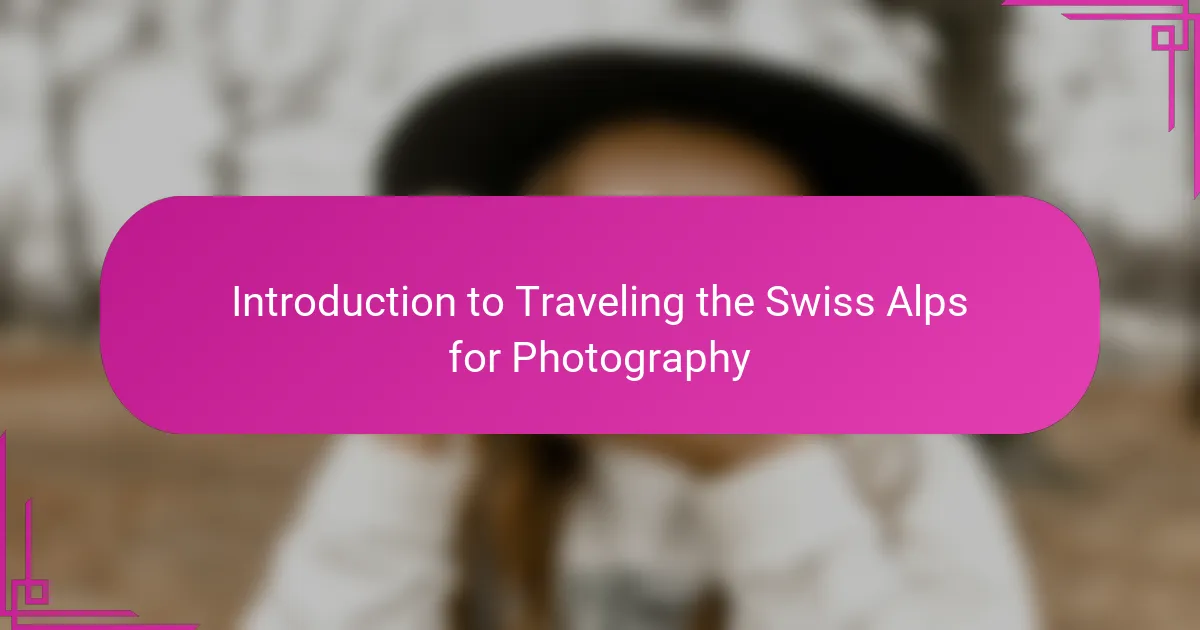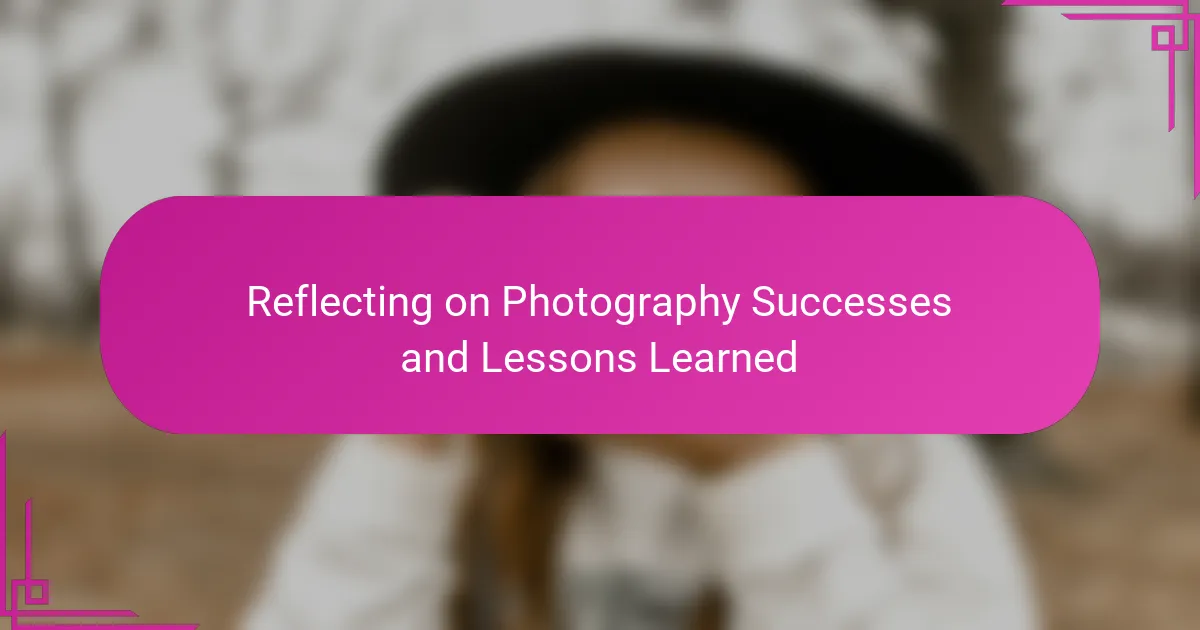Key takeaways
- The Swiss Alps offer breathtaking landscapes that inspire photographers to capture evolving moments of natural beauty.
- Timing is crucial; early autumn provides magical lighting, while dawn and dusk promise the best conditions for dramatic shots.
- Preparedness with reliable gear and adaptability to changing weather are essential for successful outdoor photography.
- Each photography outing should focus on both iconic scenes and unique angles to tell a cohesive story through images.

Introduction to Traveling the Swiss Alps for Photography
Traveling to the Swiss Alps for photography is like stepping into a living postcard. I remember feeling both excitement and a touch of nervousness as I stood before those towering peaks, wondering how to capture their majesty through my lens. Have you ever been in a place that simply takes your breath away before you even pick up your camera?
What I love most about the Swiss Alps is how every turn reveals a new scene — from snow-capped summits to quiet alpine meadows bursting with color. It’s not just about snapping pictures; it’s about immersing yourself in the atmosphere and letting the landscape tell its story. When you’re there, you realize that nature’s art is constantly evolving, and your camera becomes a tool to preserve those fleeting moments.
Photographing in such a dramatic environment challenges you to see light, texture, and scale differently. I often asked myself: how can I translate this overwhelming beauty into a single frame? It’s a question that kept me alert and pushed my creativity every day of the trip. If you’re a photographer yearning for inspiration, the Swiss Alps might just be the perfect playground.

Choosing the Best Time for Alpine Photography
Deciding when to visit the Swiss Alps for photography felt like choosing the perfect moment to catch a butterfly—it requires patience and a bit of luck. I found that early autumn offers this magical window where the golden light softens the rugged peaks, and the first dustings of snow create stunning contrasts. Have you ever wondered how light transforms a landscape? For me, those crisp, clear mornings revealed textures and shadows that simply don’t appear any other time of year.
Summer, with its vibrant wildflowers and lush green valleys, initially seemed like the ideal choice. But I quickly realized the midday sun could be harsh, washing out details and flattening the scene. Instead, I timed my shoots around dawn and dusk, when the sky blazes with color and the mountain silhouettes come alive. Have you ever chased the golden hour, only to find it was worth every early wake-up call? That soft light made all the difference in capturing the Alps’ raw beauty.
Winter is an entirely different beast, cloaked in pristine snow and low, diffused light that lends a serene and moody atmosphere. I embraced the challenge of shooting in cold, subdued conditions, knowing those frosty scenes tell a story summer never can. Reflecting on it, choosing the right season isn’t just about weather—it’s about the emotions and narratives you want your photos to express. What feeling do you want to evoke when you finally press the shutter? That’s what guided my timing above all else.

Selecting Essential Photography Gear for the Alps
Selecting the right photography gear for the Alps was a crucial part of my planning because the environment demands resilience and versatility. I packed my trusted mirrorless camera body for its lightweight feel, knowing I’d be hiking a lot, along with a weather-sealed wide-angle lens to capture those breathtaking sweeping vistas. Have you ever had gear fail you in the field? Thankfully, being prepared with sturdy, reliable equipment saved me from many potential headaches in unpredictable mountain weather.
I also made sure to bring a sturdy tripod, which became my best friend during the long exposure shots at dawn and dusk. Stability can make or break your images when the light fades, and the Alps’ dramatic skies begged for those slow shutter speeds. Packing extra batteries was another lesson learned the hard way—I underestimated how cold conditions rapidly drain power. Have you noticed how tricky cold weather can be for cameras? Bringing spares meant I never missed a moment.
Lastly, I didn’t forget small but essential accessories like lens cloths and protective filters. Between mountain mists, dust on windy ridges, and sudden rain showers, keeping the glass clean was an ongoing battle. I realized firsthand that the smallest details in preparation greatly influence the quality of the final images. So, what gear would you trust to handle both beauty and wilderness? For me, the Alps demanded more than just good equipment—they needed thoughtful, purposeful choices.

Planning Your Photography Itinerary and Routes
Planning my photography itinerary in the Swiss Alps felt like plotting a treasure map—each location promised a new gem, but timing and route mattered just as much as the spots themselves. I made sure to balance iconic viewpoints with lesser-known trails, giving me a chance to capture both the grand panoramas and intimate details of alpine life. Have you ever found that the journey between places offers as much photographic inspiration as the destinations?
I mapped out routes carefully, considering sunrise and sunset positions to maximize golden hour shots. Navigating winding mountain roads and hiking paths meant factoring in daylight hours and weather changes, which turned my itinerary into a flexible, living plan rather than a rigid schedule. This approach helped me stay open to serendipitous moments—like unexpected fog rolls—that no fixed route could predict.
Choosing where to stop wasn’t just about visuals; it was about storytelling through my images. I aimed to capture a day’s passage: the cool, quiet mornings, vibrant midday energy, and the soft, fading light that wraps the valleys in warmth. Have you ever realized how a well-planned route can turn a collection of photos into a cohesive story rather than random snapshots? That’s exactly what made this trip so rewarding for me.
![]()
Scouting and Capturing Iconic Alpine Scenes
Scouting iconic Alpine scenes felt like a delicate dance between patience and spontaneity. I often found myself hiking to vantage points before dawn, waiting in the quiet cold as the first light kissed the jagged peaks. Have you ever experienced that moment when the landscape suddenly transforms under a burst of golden light? That fleeting magic is why I kept coming back to the same spot, frame after frame.
I learned quickly that capturing the Alps isn’t just about pointing your camera at a well-known peak — it’s about seeking unique angles and hidden details that tell a story. For instance, I stumbled across a narrow ridge with a lone pine silhouetted against the sunrise, a scene I hadn’t seen in any guidebook. Those unexpected discoveries made each shot feel deeply personal, as if the mountain itself was sharing a secret.
Composing these scenes demanded more than technical skill; it required me to connect emotionally with the landscape. I asked myself, what mood do I want to convey — awe, tranquility, or adventure? That question guided my choices of light, perspective, and timing, and ultimately shaped the images I brought home. Have you thought about how your own feelings influence what you capture through the lens? For me, that connection turned mere photographs into stories worth telling.

Managing Weather and Lighting Conditions During Shoots
Managing weather and lighting in the Swiss Alps taught me to embrace unpredictability rather than fight it. I recall a morning when thick fog rolled in just as I was setting up my tripod—initially frustrating, but that soft, diffused light created an ethereal atmosphere I hadn’t planned for. Have you ever found that challenging weather sometimes gifts you with unique moods your sunny shots just can’t match?
One trick I relied on was checking detailed weather forecasts often, but also watching the sky closely with my own eyes. Mountain weather changes rapidly, so being adaptable meant I could pivot my plans—waiting out a sudden cloud burst or rushing to catch a burst of sunlight. How often do you find your best images come from moments you thought you’d missed? For me, those surprises made all the difference.
Lighting conditions were just as important as weather. Golden hours became my sacred time, but I also learned to work with harsh midday sun by seeking shaded spots or using a polarizing filter to reduce glare. Sometimes, shooting in overcast light revealed textures and colors I didn’t notice in bright sunshine. Isn’t it fascinating how different lighting tells completely different stories through your lens? That awareness kept my creative options open throughout the trip.

Reflecting on Photography Successes and Lessons Learned
Looking back on my time shooting in the Swiss Alps, I’m struck by how much I grew as a photographer. I nailed some shots with perfect light and composition that exceeded my expectations—the kind that make you want to frame them on your wall. Have you ever had a moment where everything just clicks, and your vision aligns with the scene perfectly? Those are the moments that keep me motivated to keep exploring.
That said, not every shot was a success, and I learned valuable lessons from the misses. Sometimes I rushed in poor lighting or didn’t wait long enough for the right atmosphere, resulting in photos that felt flat or uninteresting. Have you ever looked at a picture afterward and thought, “I could have done better”? Those experiences taught me patience and the importance of tuning into nature’s timing rather than forcing the shot.
One thing I now appreciate more than ever is the balance between technical preparation and creative openness. I brought solid gear and scouted well, but some of my best images came from spontaneous decisions—like adjusting angles on the fly or embracing unexpected weather shifts. How often do your greatest photography moments come from happy accidents? The Alps challenged me to blend planning with intuition, and that’s a lesson I carry into every future trip.